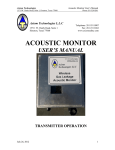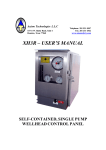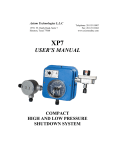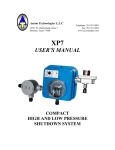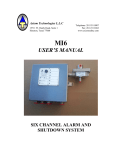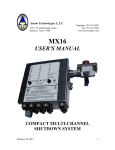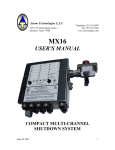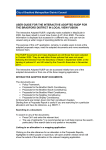Download XH5D Manual - Axiom Technologies, LLC
Transcript
Axiom Technologies LLC 15711 W. Hardy Road, Suite 1 Houston, Texas 77060 Telephone: 281 931 0907 Fax: 281 231 6562 www.axiomsafety.com XH5D-HE USER’S MANUAL SELF-CONTAINED, DUAL PUMP WELLHEAD CONTROL PANEL FOR HARSH ENVIRONMENTS Axiom Technologies LLC XH5D-HE User’s Manual 15711 W. Hardy Rd., Suite 1, Houston, Texas 77060 Phone 281 931 0907 GENERAL The XH5D-HE self-contained system is a device designed and built for protecting oil and gas production wells. It includes a switch-gage to detect high and low pressures as well as hydraulic interface for fire detection and manual ESD. The XH5D-HE is self-sufficient and doesn’t need external sources of energy or supply pressure for keeping a wellhead open and protected. It uses hydraulic fluid for driving the surface and sub-surface valves and it has two separate hand pumps and dump valves for independent control of the SSV and SCSSSV The detection of High and Low pressures is done by a switch-gage with adjustable contacts for detecting when the monitored pressure is out of acceptable limits. The switch-gage connects to an electronic module that indicates High and Low pressure conditions as well as initiates the shutdown when a pressure alarm is detected. The electronic circuits are fed by a battery module capable of keeping the system operating for five (5) years. The XH5D-HE is built to operate exposed to the elements as all hydraulic components are enclosed in a stainless steel box while the electronic circuits and battery module are enclosed in a explosion proof box inside the stainless steel box. The front of the panel includes the gages and controls as shown in Fig.1 while the inside components are shown in Fig. 2. Flow Pressure w/ High and Low Pressure Alarm “Reset” – “Test” Switch LED Indicators: -High Press. Alarm -Low Press. Alarm -Low Battery Alarm -Auxiliary Alarm -Telemetry Stdn -“Heart Beat” (System OK) “Pilot” Pressure SSV Actuator Pressure. SCSSSV Pressure Hydraulic Pump SCSSSV “SSV – Pilot” Pumping Selector Valve Hydraulic Pump “SSV – Pilot” “In Service – ESD” Selector Valve (Manual Shutdown) Fig. 1 XH5D-HE Front Panel. XH5D-ME-R2.doc 5/11/2013 Page 2 of 10 Axiom Technologies LLC XH5D-HE User’s Manual 15711 W. Hardy Rd., Suite 1, Houston, Texas 77060 Electronic Enclosure Solenoid Valve Phone 281 931 0907 Piston Accumulator (Diaphragm Accum. Directly behind) Flow Control Valve (SCSSSV Closing Delay Adjustment) SSV Dump Valve (SCSSSV Dump Valve directly behind) Hydraulic Reservoir Pilot Pressure Relief Valve Dual Hydraulic Hand Pump Hydraulic Filter Hydraulic Level Indicator Fig. 2 – XH5D-HE Enclosure’s Interior INSTALLATION – PRELIMINARY STEPS AND TESTS The XH5D-HE is typically sent with the battery module mounted backwards or in a separate package for preventing the system from operating while in transit. Also, as needed to meet shipping regulations, the device is typically shipped without hydraulic fluid in the reservoir and without Nitrogen pre-charge in the SSV hydraulic accumulator (the larger of the two accumulators. (The pilot pressure accumulator uses only 50 psi of Nitrogen pre-charge and considered safe for air transport.) Before installing the system is to be inspected to confirm that there is no external damage or indication of rough handling during shipment. In case of overseas shipments it is recommended that the XH5D-HE is tested in a work shop near the final destination to facilitate the commissioning and allow the operators to become familiar with the unit. NOTE It is recommended that the operator becomes familiar with the Hydraulic Schematic (Appendix “B”) and have a copy handy during the tests described below to better understand the system’s behavior. XH5D-ME-R2.doc 5/11/2013 Page 3 of 10 Axiom Technologies LLC XH5D-HE User’s Manual 15711 W. Hardy Rd., Suite 1, Houston, Texas 77060 Phone 281 931 0907 To commission the system follow with the steps listed below: i. Pre-charge 16 CU IN piston accumulator with about 1,000 PSI of Nitrogen ii. Confirm pre-charge of the 6 CU IN diaphragm accumulator with 50 PSI of Nitrogen. iii. Add hydraulic fluid to the reservoir, approximately one gallon. Filling is to be done with care not to exceed about 2/3rd of capacity. (In factory the units are tested with “Megaflow” ™ AW Hydraulic Oil 32, however, any quality hydraulic fluid with a AW32 will operate well.) iv. Open Explosion Proof Box mounted inside the stainless steel box and install battery module as indicated in Appendix “A”. By doing this the electronic circuit becomes energized and the green LED blinks every second (Heartbeat) to indicate the electronic circuit is operating without problem. v. Before pressurizing panel it is recommended that hydraulic fluid is circulated throughout the system to flush any particle and contaminants that could be present within the hydraulic lines. With this purpose proceed as follows: vi. vii. viii. ix. x. xi. xii. a) Set valve “In Service – ESD” to “ESD”. b) Set valve “SSV - Pilot” to “Pilot” c) Pump “Pilot/ SSV”(right side pump) in a fast mode for approximately one minute while observing the “Pilot” pressure gage (right side of the panel). This gauge should display “0” PSI but the needle oscillates with each pump strike. d) Set valve “SSV – Pilot” to “SSV” e) Again, pump “Pilot/ SSV” (right side pump) in a fast mode for approximately one minute while observing the “SSV” pressure gauge (center of the panel). This gauge should stay in “0” PSI f) Pump “SCSSSV”(left side pump) in a fast mode for approximately one minute while observing the “SCSSSV” pressure gage (left side of the panel). This gauge should stay in “0” PSI. Confirm that the plugs on the bulkhead connectors are tight before proceeding with the following steps. Set valve “In Service – ESD” to “In Service”. Set valve “SSV - Pilot” to “Pilot” Press “Reset” on switch “Test – Reset”. Pump “Pilot/ SSV” (right side pump) while observing the “Pilot” pressure gauge. Pump until reaching between 80 and 90 PSI. Inspect hydraulic lines to confirm that there is no leakage. Pump “SCSSSV” pump (left side pump) while observing the “SCSSSV” pressure gauge. Pump until reaching about 10,000 PSI. Inspect hydraulic lines to confirm that there is no leakage. As this test is being done with the SCSSSV output blocked the pressure will rise quickly and the pressure will decrease in about 20 to 30% in a few seconds after the pumping stops. This is normal; however, after the initial pressure decrease the pressure should remain stable except for the effects of temperature changes. Set valve “SSV - Pilot” into “SSV” XH5D-ME-R2.doc 5/11/2013 Page 4 of 10 Axiom Technologies LLC XH5D-HE User’s Manual 15711 W. Hardy Rd., Suite 1, Houston, Texas 77060 xiii. xiv. Phone 281 931 0907 Pump “SSV - Pilot” pump (right side pump) while observing the “SSV” pressure gauge. Pump until reaching 3,000 PSI. Inspect hydraulic lines to confirm that there is no leakage. It is normal for the pressure to fall about 15% after finishing the pumping. Set valve “In Service – ESD” to “ESD” to return all pressures to cero before moving the XH5D-HE to the field for installation. FIELD INSTALLATION Typically the XH5D-HE is mounted on one or two poles made of 3” pipe. Using two poles is preferred as it would insure safe mounting even if one of the pipe brackets used for fastening the panel to the poles would fail. The two poles should have a separation of 10” to 15” (25cm to 38cm) center to center. The pipe brackets connect to the unistrut channel mounted on the left side of the panel Fig. 3 – XH3 Mounting With the panel firmly mounted, proceed to connect the field devices as shown on Fig. 4. XH5D-ME-R2.doc 5/11/2013 Page 5 of 10 Axiom Technologies LLC XH5D-HE User’s Manual 15711 W. Hardy Rd., Suite 1, Houston, Texas 77060 Phone 281 931 0907 -1Flow-line Sensing Pressure -2Hydraulic pressure to SSV -3Hydraulic pressure to SCSSSV -4Hydraulic pressure to Manual ESD/Fire Sensor -5Hydraulic return from Manual ESD/Fire Sensor. Fig. 4 – Rear view, hydraulic lines connections. The connection to the ESD station (Connection No. 4) can be also connected to a fire plug (Included). If the fire plug used does not have a return line, some means are to be used to prevent hydraulic fluid from reaching the ground. A small amount of hydraulic fluid (approximately 3 CU IN or 50 CC) will be released in the event of a fire. XH5D-ME-R2.doc 5/11/2013 Page 6 of 10 Axiom Technologies LLC XH5D-HE User’s Manual 15711 W. Hardy Rd., Suite 1, Houston, Texas 77060 Phone 281 931 0907 OPERATION AND ADJUSTMENTS The operation of the installed panel is as follows: Starting Production: 1- Set valve “In Service – ESD” to “In Service” 2- Set valve “SSV - Pilot” to “Pilot”. 3- Press “Reset” on switch “Test – Reset”. 4- Pump “Pilot/ SSV” (right side pump) while observing the “Pilot” pressure gauge until reaching 80 to 90 PSI. 5- Pump “SCSSSV” pump (left side pump) while observing the “SCSSSV” pressure gauge. Pump until reaching the pressure necessary to open SCSSSV. Do not exceed 12,000 PSI. 6- Set valve “SSV - Pilot” into “SSV”. 7- Pump “SSV - Pilot” pump (right side pump) while observing the “SSV” pressure gauge. Pump until SSV is fully opened plus about 500psi reaching. Do not exceed actuator’s pressure rating. It is normal for the pressure to fall about 15% after finishing the pumping. 8- Check all hydraulic connections (internal and external to the panel) to confirm that there is no leakage. 9- Adjust High and Low Alarm set point on switch-gage. Closing SSV: 10- Move High or Low Alarm Set-Point until it touches the gage’s needle. The system responds closing the SSV. The corresponding LED (High or Low Pressure Alarm) blinks and the green LED stops blinking. There is no change on pilot pressure but the SSV pressure goes to cero. Re-opening the SSV: 11- Press “Reset”. The Alarm LED stops blinking while the green LED (Heartbeat) blinks every second. Also, as the solenoid trips, the pilot pressure goes momentarily to cero and slowly returns to approximately 80 PSI. 12- Pump “Pilot/ SSV” (right side pump) while observing the “Pilot” pressure gauge until reaching 80 to 90 psi. 13- Set valve “SSV - Pilot” into “SSV”. 14- Pump “SSV - Pilot” pump (right side pump) while observing the “SSV” pressure gauge. Pump until reaching 3,000 PSI. It is normal for the pressure to fall about 10% after finishing the pumping. Do not exceed 3,000 PSI. Initiating ESD (Clothing of the SSV and then SCSSSV): 15- Set valve “In Service – ESD” to “ESD”. Shutdown Delay adjustment for SCSSSV: 16- The SCSSSV closes only in case of manual ESD and/or by the activation of the fusible plug. 17- When an ESD is initiated, the “Pilot Pressure” and “SSV Pressure” shown on the front of the panel go to zero psi in the first one or two seconds. Then after some time delay, the SCSSSV pressure slowly goes down to zero. 18- The time lapsing between the activation of the ESD can be adjusted by adjusting the “Flow Control Valve” (shown on Fig.2, page 3 of this manual). XH5D-ME-R2.doc 5/11/2013 Page 7 of 10 Axiom Technologies LLC XH5D-HE User’s Manual 15711 W. Hardy Rd., Suite 1, Houston, Texas 77060 Phone 281 931 0907 19- Turn knob of “Flow Control Valve” a small fraction of a turn in the direction of the clock pointers to increase time delay and in the opposite direction to reduce it. 20- For initial setting close the “Flow Control Valve“ by turning knob clockwise all the way and then turning it back one half of a turn Re-opening the well after ESD: 21- Repeat steps 1 through 9 of this list. Adjusting High and Low Pressure Alarms: 22- Turn red knob to adjust High pressure Alarm to the desired High Pressure Alarm. Repeat the same with the black knob to set the Low Pressure Alarm. HYDRAULIC CIRCUITS The hydraulic circuits are shown on appendix “B”. ELECTRONIC SYSTEM By replacing most of the hydraulic logic with electronic circuits, the most failure prone components are removed and the hydraulic circuit greatly simplified to a few reliable components. In this way, by having self diagnostic in the electronics and a simplified hydraulic system, the XH5D-HE offers a reliability level not seen on any of the typical self-contained wellhead control panel. Furthermore, if a failure would occur, the diagnostic and correction of the problem is much simpler because of the simplicity of the hydraulics. ` Telemetry Shutdown Alarm Auxiliary Alarm a See Appendix C for Auxiliary or Telemetry Shutdown Spare EOZ Fig. 4 – External Alarm Termination Box XH5D-ME-R2.doc 5/11/2013 Page 8 of 10 Axiom Technologies LLC XH5D-HE User’s Manual 15711 W. Hardy Rd., Suite 1, Houston, Texas 77060 Phone 281 931 0907 When operating under normal conditions (no alarms) the electronic system flashes the green LED every second (heartbeat) to indicate that the electronic system is operating without problems. If any alarm is detected the green LED stops flashing and the solenoid valve is tripped to initiate shutdown of the SSV only. The red LED corresponding to the detected alarm starts flashing and it is latched in such way that even if the alarm condition would go away or a new alarm would be detected; the first detected alarm only will flash, holding the information for the operator to see the actual cause of the shutdown. For example, if a High Pressure Alarm would occur, the corresponding High Pressure Alarm LED will flash and keep on flashing even if the high pressure alarm would go away and now the needle is touching the Low Pressure contact. The first detected alarm will keep displaying until the operator presses “Reset”. A total shutdown or “ESD” (closing of the SSV and SCSSSV) would be executed only in the case of Fire Alarm (fusible plug) and/or Manual Shutdown. Once the operator presses “Reset” while the alarm still present, the system resets the solenoid valve to allow the re-opening of the well and alternatively flashes the green LED and corresponding alarm red LED, if the alarm still present. The system tolerates the existing alarm for 30 minutes before re-initiating the shutdown and prevents the system from being left in production while operating in an abnormal condition. Once the pressure alarm clears, only the green LED remain flashing. The “Test” function allows the operator to see the last alarm and also confirm that all the indicator LEDs are working properly. This is, when pressing “Test”, the system respond by flashing the last detected alarm for about two seconds and then flashes the red LEDs in sequence. The battery module provides two separate voltages, 3.6 VDC to feed the microcontroller circuits and 14.4 VDC to operate the solenoid valve. Both voltages are periodically monitored to confirm the system has the proper battery supply to operate reliably. If the system detects a low voltage, the green LED and the “Low Battery” red LED alternates flashing but the system remains in operation. However, if a voltage falls too far down for insuring reliable operation, then a shutdown is executed and only the “Low Battery” red LED flashes. Given the low power consumption of the system it is expected that the operator will be able to detect the warning signs of low battery and should be able to replace the battery module before it gets to the point where the system causes shutdown because low battery. The battery module is to be replaced as soon as the system shows signs of low voltage to insure the system continues operating reliably. The battery module has an expected life of five years XH5D-ME-R2.doc 5/11/2013 Page 9 of 10 Axiom Technologies LLC XH5D-HE User’s Manual 15711 W. Hardy Rd., Suite 1, Houston, Texas 77060 Phone 281 931 0907 WARNING! Do not attempt to recharge the batteries on the battery module as this may cause an instable condition that may result in a violent explosion. Return the spent battery modules to Axiom Technologies or to any lithium battery recycling facility. See the instructions shown on Appendix “A” for replacing the battery module. XH5D-ME-R2.doc 5/11/2013 Page 10 of 10












